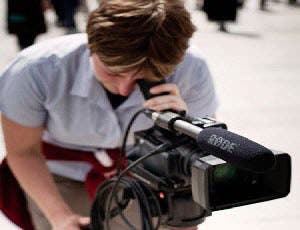Every job I’ve been sent on has begun with me dreaming about the images that I’ll capture. But things never unfold the way they do in my mind. I can’t tell you how many gymnasiums I’ve shot in, but I have to find new ways of making interesting images, and I have to do it quickly- when traveling your schedule is going to be packed, with little time to set up lighting and audio. But in this article I’m going to share a few of the tricks and techniques I employ in the field.
The Lowel Pro Tota Light is the one light to rule them all. It’s small, has barn doors, a built-in umbrella mount and swivel, and 750-watt bulb makes this light, in my opinion, the most versatile light ever. All of the following interview shots were lit with this light- augmented with either a reflector or an umbrella.
My “hero” setup is the Tota light and the Westcott Compact 43″ umbrella. This gives me the option of a traditional bounce light or I can remove the black cover and use it as a shoot-through umbrella. This is especially important in tight spaces.

An added benefit of having a 750-watt light is that if you’re really pressed for space, just bounce that light off a wall or the ceiling- sometimes you just need to hit a good exposure. Never forget that you can “relight” in post, so if all you can do is light flat just to get exposure, it’s better than nothing.
But maybe you want the look of multiple lights. This is where studying natural or available light is beneficial. Take that aforementioned “hero” setup, put it to the side of your subject, a quarter of the distance between the subject and the camera, then set up your 22-inch reflector opposite as a fill light. Don’t have another stand to carry the reflector? Prop that reflector up on a chair.
One other thing to keep in mind, going back to the idea of natural or available light, take a look at your environment. What is the ambient light source, and can you use it to your advantage? It’s always important, when shooting on the fly, to keep your wits about and use your environment to your advantage. The below shot, an interview with Clint Bryant, I have my Tota and Umbrella to the right of the camera, reflector on the left, the hair light is actually from the spot lights that illuminate the display behind him. Even though I only brought one actual light source with me, I used the light already present in the room to complete a 3-light look.

This brings me to audio. Audio is just as important as lighting, maybe more so. And just like lighting, it can be very difficult, in the field, to capture nice, clean audio.
For this reason I think it’s important to have at least two different types of microphones. You don’t need the most expensive microphones, it’s much more important to know both how to use them and how to work with your audio in post.
My Sony UWP with the Rode Lavaliere Mic is my workhorse for interviews. This combined with my JuicedLink RM202 is so hot that I can max out the attenuation on the Sony (which narrows the pickup field) and still risk my audio clipping. I’d much rather have to turn down the preamp than have to boost gain on my camera or Zoom H4n.



But having only one lavaliere microphone doesn’t cut when you’re interviewing multiple people in the same frame. This is where that MXL mic and my Rode VideoMic come into play. Setting these up just out of frame but as close to the subjects as possible is crucial. For the shot below (the Price twins), I’m actually using all three of my microphones. The two cardioid mics are just outside of the frame, my Sony UWP is actually hidden between the twins. This might seem a bit overkill, but I was also picking up a lot a air conditioner noise. This is where my post workflow comes into place. I recorded some pre-roll to grab room tone, removed the air conditioner from the audio, but that made each individual mic too quiet, blending the three mics in post allowed me to get an average -10-12db in the final video.


Finally, shooting stable footage in tight spaces or in fast-paced situations. This is where I use my Manfrotto 681b monopod with the 678 base. Pictured below is a rig for a shoot in a cramped brewery. There was absolutely no room for my tripod, plus the brewer was constantly moving so I had to be sure I could stay out of his way. So for this shoot I put my camera on the monopod, attached a Rode NTG-2 into my JuicedLink, and shot exclusively with my 24mm lens. This way I could keep close to my subject to capture good audio but still get the environment in the frame.

The moral of the story is: set yourself up for success by carefully choosing the gear you carry with you, but also, pay attention to what you have available around you.




